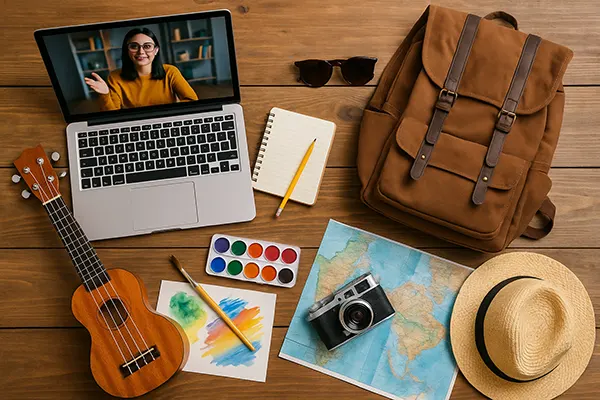
How to Invest in Yourself: Courses, Hobbies or Travel – Which Brings Greater Value
In 2025, self-investment has become more than a personal development trend — it’s a necessity in a fast-changing world. People increasingly evaluate whether to spend on education, experiences, or leisure. But the real question remains: which of these paths offers the best long-term return — enrolling in a course, taking up a new hobby, or exploring the world through travel?
Understanding the Real Cost and Benefit of Self-Investment
The first step in choosing how to invest in yourself is understanding what you are truly paying for and what you get in return. Online courses or professional certificates often provide tangible outcomes — skills that can be monetised or used to progress in your career. For example, a data analytics course can lead to a higher-paying position or freelance opportunities, making it a direct financial investment.
Hobbies, on the other hand, may not seem financially driven but they contribute significantly to mental well-being. Painting, music, or gardening develop patience, focus, and creativity — traits that indirectly enhance professional performance and personal balance. Meanwhile, travel offers cultural exposure, adaptability, and perspective — qualities that shape your decision-making and empathy in ways no classroom can replicate.
Each option has its own currency of return: education builds expertise, hobbies enhance stability, and travel broadens awareness. The key is identifying what kind of “profit” matters most to you — financial, emotional, or experiential.
Comparing Value Over Time
Courses often produce visible results faster, especially if they align with market demand. Within six months, many learners see measurable growth in skills and income. Hobbies, however, provide cumulative emotional benefits — reduced stress and long-term satisfaction, which cannot be quantified easily but strongly influence quality of life.
Travel tends to have a delayed yet profound effect. People often report a shift in values or career focus after significant journeys. In 2025, remote work and digital nomadism have made travel even more meaningful, as individuals combine exploration with professional growth.
Ultimately, the long-term value of self-investment lies in consistency. A single course or trip won’t change your life, but a pattern of thoughtful self-improvement certainly can.
The Psychology Behind Investing in Yourself
Psychologically, self-investment activates a sense of control and motivation. When you consciously allocate time or money towards personal development, your brain interprets it as self-worth affirmation. This, in turn, boosts confidence and determination to maintain progress.
Research in behavioural economics supports this: people are more committed to goals they financially invest in. Paying for a course or booking a creative workshop reinforces accountability. Similarly, planning a meaningful journey or buying equipment for a hobby triggers emotional engagement — it becomes part of your identity.
In a society where burnout and disconnection are common, self-investment acts as a mental reset. It redefines success beyond productivity, helping individuals align their goals with authentic satisfaction rather than external approval.
Motivation and Long-Term Mindset
Motivation is not a constant resource — it fluctuates. The best form of self-investment, therefore, sustains motivation through tangible progress or emotional reward. For instance, learners who document their achievements tend to persist longer in their studies, while hobbyists who share their creations gain motivation through community feedback.
In 2025, digital communities amplify this effect. Online study groups, creative forums, and travel communities allow people to celebrate progress together, turning self-investment into a shared experience rather than a solitary journey.
When psychological satisfaction meets practical growth, the investment in yourself becomes self-sustaining — it encourages continuous curiosity and resilience.

Testing Your Path: The Pilot Strategy
Before committing significant resources, a pilot approach allows you to experiment without financial pressure. It’s the equivalent of “testing the waters” — a crucial mindset in uncertain times. For example, you can try a free online course before enrolling in a full programme, or join a one-day workshop before signing up for long-term lessons.
In the realm of hobbies, start small — rent instruments, borrow art supplies, or join community clubs. This lets you gauge genuine interest without unnecessary spending. Likewise, short local trips can serve as a test before larger travel commitments.
This pilot strategy aligns with modern financial mindfulness. It encourages reflection before action and helps identify what truly resonates with you, ensuring your self-investment brings fulfilment rather than regret.
Real-Life Case Studies
Consider Emma, a 32-year-old marketing professional who enrolled in a public speaking course. Within six months, she not only overcame her fear of presentations but also secured a managerial role. Her investment of £300 turned into measurable career growth and self-confidence.
Another example is Jacob, who discovered woodworking during lockdown. What began as a weekend hobby evolved into a small side business by 2025. His return wasn’t just financial — it was emotional stability and purpose.
Meanwhile, Sophie’s decision to spend her savings on solo travel through South America changed her perspective on life and career. She returned with fresh ideas and a new sense of direction, proving that sometimes the best returns are internal, not monetary.
